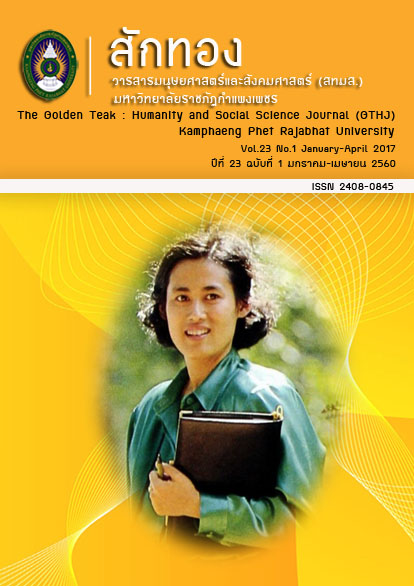ความเป็นองค์กรอัจฉริยะของโรงเรียนสังกัดสำนักงานเขตพื้นที่ การศึกษาประถมศึกษาเลย เขต 1
Main Article Content
Abstract
บทคัดย่อ
การวิจัยครั้งนี้ มีวัตถุประสงค์ 1. เพื่อศึกษาระดับความเป็นองค์กรอัจฉริยะของโรงเรียนตามความคิดเห็นของข้าราชการครูและบุคลากรทางการศึกษา สังกัดสำนักงานเขตพื้นที่การศึกษาประถมศึกษาเลย เขต 1 และ 2. เพื่อเปรียบเทียบความเป็นองค์กรอัจฉริยะของโรงเรียนตามความคิดเห็นของข้าราชการครูและบุคลากรทางการศึกษา สังกัดสำนักงานเขตพื้นที่การศึกษาประถมศึกษาเลย เขต 1 จำแนกตามตำแหน่งหน้าที่ ประสบการณ์การทำงานและขนาดของโรงเรียนตามกรอบแนวคิดความเป็นองค์กรอัจฉริยะ 5 ด้าน ได้แก่ 1) ด้านการจัดการความรู้ 2) ด้านการวางแผนกลยุทธ์ 3) ด้านการมีวิสัยทัศน์ 4) ด้านการจัดการทรัพยากรมนุษย์ และ 5) ด้านการใช้เทคโนโลยีและนวัตกรรม กลุ่มตัวอย่าง ได้แก่ ผู้บริหารสถานศึกษา จำนวน 169 คนและครูผู้สอน 284 คน รวมทั้งสิ้น 317 คน เครื่องมือที่ใช้ในการเก็บรวบรวมข้อมูลเป็นแบบสอบถามแบบมาตราส่วนประมาณค่า (Rating Scale) 5 ระดับ มีค่าอำนาจจำแนกตั้งแต่ 0.40 ถึง 0.72 และค่าความเชื่อมั่นของแบบสอบถามทั้งฉบับเท่ากับ 0.96 สถิติที่ใช้ในการวิจัย ได้แก่ ค่าเฉลี่ย ส่วนเบี่ยงเบนมาตรฐาน และสถิติที่ใช้ในการทดสอบสมมติฐาน ได้แก่ t-test และ F-test ผลการวิจัยพบว่า (1) ความเป็นองค์กรอัจฉริยะของโรงเรียนสังกัดสำนักงานเขตพื้นที่การศึกษาประถมศึกษาเลย เขต 1 โดยภาพรวม อยู่ในระดับมาก เมื่อพิจารณารายด้าน พบว่า มีความเป็นองค์กรอัจฉริยะอยู่ในระดับมากทุกด้าน และเมื่อพิจารณาค่าเฉลี่ยความเป็นองค์กรอัจฉริยะที่มีค่ามาก 3 อันดับแรก พบว่า ด้านที่มีค่าเฉลี่ยสูงสุด คือ ด้านการบริหารจัดการทรัพยากรมนุษย์ รองลงมา ได้แก่ ด้านการมีวิสัยทัศน์และด้านการวางแผนกลยุทธ์ ตามลำดับ ส่วนด้านที่มีค่าเฉลี่ยต่ำสุด คือ ด้านการจัดการความรู้ (2) ความเป็นองค์กรอัจฉริยะของโรงเรียนสังกัดสำนักงานเขตพื้นที่การศึกษาประถมศึกษาเลย เขต 1 โดยภาพรวมเมื่อจำแนกตามตำแหน่งหน้าที่ไม่แตกต่างกัน แต่เมื่อพิจารณาเป็นรายด้าน พบว่า มีเพียง 1 ด้าน คือ ด้านการบริหารจัดการทรัพยากรมนุษย์ ที่แตกต่างกันอย่างมีนัยสำคัญทางสถิติที่ระดับ .05 นอกนั้นไม่แตกต่างกัน (3) ความเป็นองค์กรอัจฉริยะของโรงเรียนสังกัดสำนักงานเขตพื้นที่การศึกษาประถมศึกษาเลย เขต 1 เมื่อจำแนกตามประสบการณ์การทำงานโดยภาพรวมและรายด้านไม่แตกต่างกัน 4. ความเป็นองค์กรอัจฉริยะของโรงเรียนสังกัดสำนักงานเขตพื้นที่การศึกษาประถมศึกษา เขต 1 เมื่อจำแนกตามขนาดของโรงเรียนโดยภาพรวมและรายด้าน คือ ด้านการจัดการความรู้ ด้านการมีวิสัยทัศน์และด้านการบริหารจัดการทรัพยากรมนุษย์ มีความแตกต่างกันอย่างมีนัยสำคัญทางสถิติที่ระดับ .05 นอกนั้นไม่แตกต่างกัน
The Intelligent Organization of Schools Under Loei Primary Educational Service Earea Office 1
ABSTRACT
This research was designed 1. to explore the level of the intelligent organization of schools under Loei Primary Educational Service Area Office 1 according to the teachers and educational personnel's opinions, and 2. to compare the intelligent organization of schools according to the teachers and educational personnel's opinions. The research participants were classified by their standing positions, work experience and school sizes. The framework of the intelligent organization was applied for the research which consisted of 1) knowledge manage, 2) strategic planning, 3) visioning, 4) human resource management, and 5) technology and innovation implementation. The sample consisted of 169 administrators and teachers 284 people total of 317 people, The instruments used to collect data was the rating scale (Rating scale) 5 levels. with the discrimination from 0.40 to 0.72 and the reliability of the entire questionnaire was 0.96. The statistics used included the mean, standard deviation, The statistics used to test the hypothesis t-test and F-test. The findings were found as follows : (1) The overall and by aspect of the intelligent organization of schools under Loei Primary Educational Service Area Office 1was obviously found at a high level. The first three highest mean were the human resource management then followed by visioning and strategic planning respectively. The lowest mean was the knowledge management. (2) The respondents classified by their standing positions have indifferent opinions about the intelligent organization of schools in overall aspect but by aspect clearly found that their opinions were different only about the human resource management with the statistical significance at .05 level. (3) The respondents classified by their work experience was revealed that their opinions about the intelligent organization of schools in overall aspect as well as by aspect were indifferent. (4) When classifying the school sizes, it was found in overall aspect and by aspect that the respondents' opinions about the aspects of knowledge management, visioning and human resource management were different with the statistical significance at .05 level. The other aspects were indifferent.
Article Details
บทความที่ได้รับการตีพิมพ์เป็นลิขสิทธิ์ของวารสาร สักทอง : วารสารมนุษยศาสตร์และสังคมศาสตร์ สถาบันวิจัยและพัฒนา มหาวิทยาลับราชภัฏกำแพงเพชร
ข้อคิดเห็นใดๆ ที่ปรากฎในวารสารเป็นวรรณกรรมของผู้เขียนโดยเฉพาะ ซึ่งมหาวิทยาลัยราชภัฏกำแพงเพชรและบรรณาธิการไม่จำเป็นต้องเห็นด้วย


